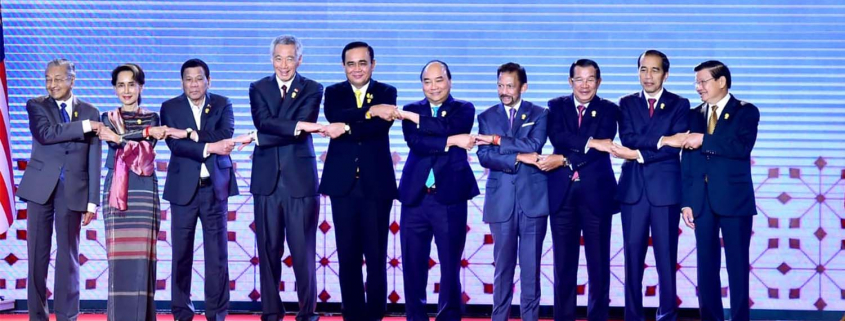Decoding the Indo-Pacific outlook
See original post in Bangkok Post
The 34th Asean Summit wrapped up last week in Bangkok, with the adoption of a crucial document known as the Asean Outlook on the Indo-Pacific (AOIP). Prime Minister, Gen Prayut Chan-o-cha, regarded the AOIP as a milestone as the bloc now has a unified perspective on how to deal with external partners in the region.
In terms of the text, the AOIP has changed from the first draft distributed by Indonesia in August 2018 during the 51st Asean Foreign Ministers Meeting in Singapore. The first draft was still very Indonesia-centric in a sense, as it weighs on connecting the Indo-Pacific vision with Indonesia’s Global Maritime Fulcrum strategy. In that draft, Asean’s role is projected to become the fulcrum of connectivity and inclusive norm-setter.
While principally the AOIP shares a similar objective with its previous draft, there are not so many strategic directions outlined that champion Asean’s role to become a central Indo-Pacific driving force. The previous draft is rather more concrete providing action proposals, such as developing a Master Plan on Indo-Pacific Connectivity, creating the Indo-Pacific Forum on Sustainable Development Goals, and establishing the Indo-Pacific Forum for Safety Navigation and Mitigating Natural Disasters.
The adopted version is instead built on traditional principles of Asean, but with similar goals of building perspective and providing narrative on how Asean should be driving the region in the midst of global uncertainty and great powers’ rivalry.
The AOIP is not a product, but a process. The instrument is non-legally binding, different from what Indonesia’s former foreign minister, Marty Natalegawa, suggested in 2014 for an Indo-Pacific Treaty, to which, in its Chairman Statement of the 24th Summit, Asean leaders “welcomed Indonesia’s efforts to propose a Treaty of Friendship and Cooperation in the wider Indo-Pacific region”.
Rather, it emphasises norm-building processes, setting up a wide range of principles, notably Asean centrality, habit of dialogue, and inclusivity.
The AOIP serves as a “learning module” for all Asean member states in dealing with external powers’ expanding influence in the Southeast Asian region and beyond through different visions of regional architecture concepts brought forward by other competing powers. What comes after the adoption for Asean is to exercise these guidelines in responding to various Indo-Pacific, or other geostrategic proposals.
While it seems like there is limited content in the AOIP, the adoption signalled Asean’s take on maintaining order in an age of uncertainty and deficit of multilateralism, primarily in the changing regional architecture influenced by the expansion of China through the Belt and Road Initiative (BRI) and the US Free and Open Indo-Pacific Strategy (FOIP), perceived as its counter balance. The AOIP does not take sides. Although, for some, picking “Indo-Pacific” as a title could be regarded as a “containment policy” against China, Asean’s proposal is claimed as the only geostrategic concept grounded on inclusive collaboration with any players in the international community and avoiding rivalry. This was seen from Indonesian President Joko Widodo expressing his keenness to invite China as a potential partner in advancing Indo-Pacific cooperation at the 21st Asean-China Summit 2018.
The AOIP adoption indeed stole some momentum as it was consensually approved in the midst of an accelerated trade war between Beijing and Washington, which has already started to bite Asean members’ economies. It still remains a challenge to reconcile these two competing powers, especially as the US report that came out recently already pointed a finger at Chinese coercion towards Southeast Asian countries being an identified threat. Nonetheless, if utilised strategically, it can play a significant role serving as a “buffer zone” towards the spread of the major powers’ influence in Southeast Asian, depending how Asean, or Indonesia as the key drafter, can better make use of this strategy.
As an Indo-Pacific vision that exerts collaboration without leaving anyone behind, credit for the AOIP goes to Jakarta for its success in extending and promoting its foreign policy; free and active principles, to Asean — fundamentals of Indonesia’s foreign policy that amplify non-alignment with any major powers. If Asean members are able to adhere to AOIP to avoid disunity, it can turn into a powerful instrument. If not, then it will remain a ceremonial document like other Asean meeting outcome documents.
The vision appears to be idealistic. Past experience shows Asean hardly maintains its centrality on issues that are sensitive in nature, such as the South China Sea dispute, despite the grouping’s stance on the region as a zone of peace, freedom and neutrality. While it is still too early to assess the future trajectory of Asean in taking the AOIP in its steps forward, assessing the success rate of all member states sticking to these principles could be a question as its members have historically aligned to a certain “patron” country.
Dio Herdiawan Tobing is a Senior Fellow with the Asean Studies Center Universitas Gadjah Mada in Indonesia and Vicky Barreto is a MA Candidate in Development Studies at Sussex University in the UK.



